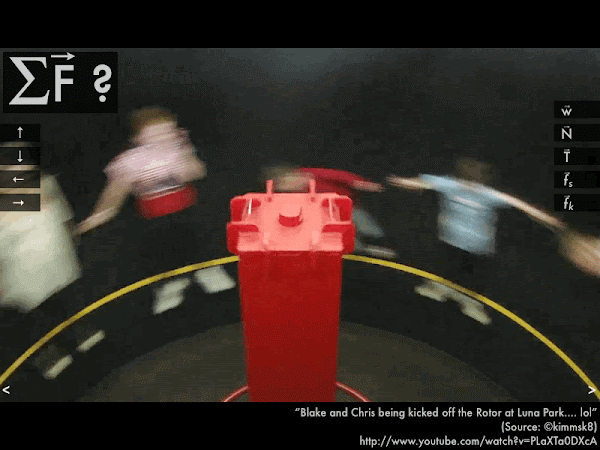Cuesta College, San Luis Obispo, CA
Students have a bi-weekly online reading assignment (hosted by SurveyMonkey.com), where they answer questions based on reading their textbook, material covered in previous lectures, opinion questions, and/or asking (anonymous) questions or making (anonymous) comments. Full credit is given for completing the online reading assignment before next week's lecture, regardless if whether their answers are correct/incorrect. Selected results/questions/comments are addressed by the instructor at the start of the following lecture.
The following questions were asked on reading textbook chapters and previewing a presentation on uniform circular motion.

Selected/edited responses are given below.
Describe what you understand from the assigned textbook reading or presentation preview. Your description (2-3 sentences) should specifically demonstrate your level of understanding.
"The sum of the total forces acting on an object must be exactly equal to the velocity squared times the mass, all divided by the radius in order for the net force to be center seeking."
"The requirements needed for uniform circular motion. The net force must be equal to mv2/r and directed in towards the center."
"Centripetal force is not another force, but rather it represents the net force that is pointed toward the center of a circular path. Centripetal force points in the same direction as the acceleration, which is also pointed toward the center of the circle."
"For uniform circular motion, the change to the velocity is its direction and not its magnitude."
"I totally get why I have to hang on to the handle of the car door while my husband drives fast around curves! Or at least now I am aware of the fact that my body is sliding off the circular motion on to a tangent to the circle."
Describe what you found confusing from the assigned textbook reading or presentation preview. Your description (2-3 sentences) should specifically identify the concept(s) that you do not understand.
"With centripetal force, I know the forces go towards the middle but I'm confused why. Is there another force acting in the opposite direction?"
"Determining whether Newton's first or second laws apply to circular motion."
"Why centripetal force happens, and what centrifugal forces are."
"Centrifugal force, and how that relates to the subjective experience of an object being flung from the circle of motion."

first; is zero. **** [4] second; points to the left. ************ [12] second; points to the right. ************************* [25] (Unsure/lost/guessing/help!) ***** [5]

first; is zero. ********** [10] second; points upwards. ************************ [24] second; points downwards. ***** [5] (Unsure/lost/guessing/help!) ******* [7]

first; is zero. ** [2] second; points to the left. *********** [11] second; points to the right. *************************** [27] (Unsure/lost/guessing/help!) ****** [6]

first; is zero. ********* [9] second; points upwards. ******* [7] second; points downwards. *************************** [27] (Unsure/lost/guessing/help!) *** [3]

first; is zero. *** [3] second; points to the left. ************************** [26] second; points to the right. ************ [12] (Unsure/lost/guessing/help!) ***** [5]

first; is zero. *********** [11] second; points upwards. *****[4] second; points downwards. ************************** [26] (Unsure/lost/guessing/help!) ***** [5]

first; is zero. ************ [12] second; points upwards. ***** [5] second; points downwards. *********************** [23] (Unsure/lost/guessing/help!) ****** [6]
Ask the instructor an anonymous question, or make a comment. Selected questions/comments may be discussed in class.
"Is there any way the reading assignments and homework reports can be due the morning just before class starts? I don't have much time to complete them the day before but I have a lot of time in the morning before class." (The online reading assignments and homework reports are due the night before class, in order to allow me enough time to read everyone's questions and comments, compile answers to the multiple-choice questions, look at which topics/problems students are having problems with, and then plan out the specific concepts and examples that will be covered in class the next day. The assignments are always open in the afternoon after the end of each class, so just plan ahead and don't wait until it's too late.)
"The textbook states that static friction is usually more than kinetic friction. When is it less than the kinetic friction?" (Maybe pushing a big stone block across a sandy beach, or scraping a hand plane across a piece of really soft wood--once you get it moving with a certain amount of force (overcoming static friction) and try to keep pushing it with that same force, it plows up the stuff underneath it and grinds to a halt (as the kinetic friction force is greater than your unsticking force for static friction). So kinetic friction forces are greater than static friction forces when the surfaces are "injuring" each other, rather than when just sliding over each other.)
"Stay true." (Word.)
"How do the fictitious centrifugal forces relate to all this? What are they?" (They're "fictitious" because these are forces you seem to "experience" when undergoing circular motion (because of your subjective inner ear sensations), but aren't in the directions that real forces are actually exerted on you. So don't try to be the object undergoing circular motion (this leads to misleading fictitious forces in wrong directions), look at the object undergoing circular motion (and only consider the real forces actually exerted it).)
No comments:
Post a Comment